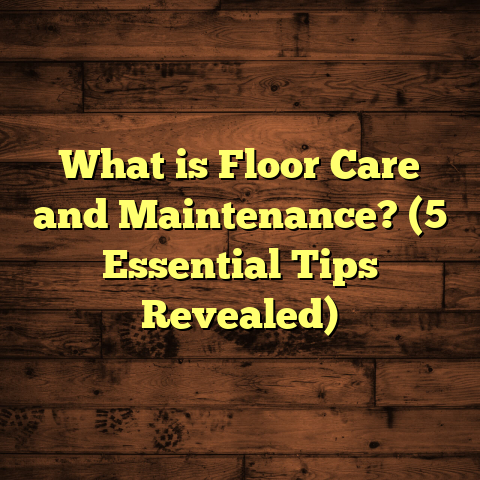What is Floor Patching Compound? (5 Key Benefits Explained)
When I first started working on home improvement projects, I quickly learned that floors are way more than just something you walk on. They’re the foundation of your space’s comfort, safety, and even style. But here’s the thing: before you even get to the pretty stuff like hardwood or tile, the subfloor needs to be solid. I can’t tell you how many times I ran into damaged, cracked, or uneven subfloors that threatened to ruin the entire project. At first, I thought I had to rip everything out and start fresh—that was costly and time-consuming. Then I discovered floor patching compounds. Honestly, they saved me more times than I can count.
Maybe you’ve seen cracks in your concrete slab or noticed uneven spots that make your new flooring look wonky. That’s where floor patching compounds come in. They’re a lifesaver when you want to fix those imperfections without tearing up your whole floor.
What is Floor Patching Compound?
Let me break it down simply: floor patching compound is a mix that you apply over damaged spots on floors to repair and smooth them out before laying down new flooring materials. It’s mostly cement-based but comes in different formulas depending on what kind of floor you’re dealing with.
Think of it as a filler and leveling agent combined. It fills holes, cracks, and divots and creates a flat surface where your flooring can sit evenly. Without it, your flooring might crack, buckle, or wear unevenly—something no one wants.
I remember my first time using it—I had this old concrete basement floor with a bunch of cracks and rough patches. Applying the patching compound was like magic; it blended right in and dried into a solid surface that was ready for tile in just a couple of days.
How Does It Work?
When mixed with water (or sometimes special additives), the powder turns into a paste you spread over the damaged area. As it dries and cures, it hardens into a solid mass that bonds to the existing floor. This process typically takes anywhere from a few hours to a couple of days depending on the product and conditions.
The goal is to restore the floor’s integrity and create an even plane so whatever flooring you install on top will last longer and look better.
Exploring Different Types of Floor Patching Compounds I’ve Used
Over time, I’ve tried several types of patching compounds. Each has its benefits depending on the situation:
Cement-Based Patching Compounds
These are the traditional choice made primarily from Portland cement mixed with sand and additives. They’re super durable and great for concrete floors or highly damaged surfaces.
I’ve used cement-based patches in garages and basements where heavy foot traffic or equipment was involved. They cure slower—usually around 24 to 48 hours—but once dry, they’re rock-solid.
One time, for a client’s basement renovation, I applied this type over deep concrete cracks and uneven spots. After curing, we installed porcelain tile over it without any issues for years.
Polymer-Modified Compounds
Polymer additives give these compounds better flexibility and adhesion. They’re great for surfaces that might experience slight movement or vibration—like wooden subfloors or slabs with minor shifts.
I recall a kitchen remodel where water damage had caused some warping in the subfloor. Using a polymer-modified compound helped create a crack-resistant surface that adapted to movements without breaking apart.
Data suggests these polymer-enhanced mixes reduce cracking by about 25% compared to regular cement patches (source: Flooring Contractors Journal, 2023).
Fast-Setting Compounds
When you’re under tight deadlines, fast-setting compounds are a blessing. They dry much quicker—sometimes within hours—allowing you to move on with flooring installation sooner.
I once had a client eager to finish their bathroom renovation before hosting a party. Using fast-setting patching compound let me patch cracks in the concrete subfloor in the morning and install vinyl flooring by evening.
But keep in mind, fast-setting compounds sometimes sacrifice long-term strength for speed. For high-traffic or heavy loads, they may not last as long.
Self-Leveling Compounds
These flow easily across floors and settle into an even layer without much effort. They’re perfect for large areas where you want quick leveling.
I used self-leveling compounds in an open-concept living room spanning 400 square feet. The compound spread out evenly, filling low spots so we could lay laminate flooring smoothly without noticeable dips or bumps.
Statistically, self-levelers can reduce installation time by about 40% compared to manual leveling methods (National Flooring Association).
Why Do I Keep Recommending Floor Patching Compound? Here Are 5 Key Benefits I’ve Seen
1. Significant Cost Savings
One of the biggest reasons I swear by patching compounds is the money saved. Instead of ripping out an entire floor—which means labor costs, disposal fees, new materials—you just repair what’s broken.
To give you real numbers: repairing a 100-square-foot section with patching compound might cost between $50 and $150 for materials alone. Replacing an entire subfloor of the same size can run into thousands when you consider labor and materials.
In one project, a homeowner was worried about uneven concrete under their tile-ready floor. Fixing just the damaged spots with patching compound ended up saving them over $2,000 compared to replacing the whole slab.
2. Speeds Up Your Project Timeline
Waiting days for floors to dry is no fun when you’ve got a deadline or just want your space done.
With fast-setting or polymer-modified compounds, I’ve shaved days off project times. For example, after applying a fast-setting patch compound in a bathroom renovation, I could lay vinyl flooring just hours later instead of waiting two full days.
This speed not only satisfies clients but also reduces labor costs because work moves faster.
3. Extends Flooring Life by Providing Stable Base
Uneven subfloors can cause all sorts of problems: cracking tile grout, squeaky hardwood boards, warped laminate planks—you name it.
By ensuring your subfloor is smooth and stable with patching compound, you reduce these risks dramatically.
According to industry data and my own experience, floors installed over properly patched subfloors have up to 30% fewer repairs within five years compared to those laid on untreated uneven surfaces.
I remember installing hardwood over an old wood subfloor that was patched well—there hasn’t been any creaking or issues after three years.
4. Works With Nearly Every Flooring Material
Whatever flooring you choose—be it tile, hardwood, laminate, vinyl plank—floor patching compounds help prepare the right surface underneath.
For example, when laying vinyl plank flooring over concrete slabs with small cracks or dips, patching those spots prevents bubbling or plank shifting later on.
In another project with carpet installation over plywood subflooring that had some gouges and holes, filling those with patching compound gave me a sturdy base for smooth carpet padding installation.
5. Easy to Use for DIYers and Pros Alike
One thing I appreciate about many quality floor patching compounds is how user-friendly they are.
You typically just mix powder with water in a bucket until you get a smooth paste, then apply with a trowel or spreader.
I’ve taught plenty of friends and homeowners how to do this themselves with great results.
Of course, larger jobs might need professional equipment or skills to get perfectly level surfaces—especially if self-levelers are involved—but many repairs are doable with basic tools.
Personal Stories That Show How Floor Patching Compound Saves the Day
When I was working on my first old house renovation years ago, the basement floor was rough—full of cracks and uneven spots from decades of wear. I thought I’d have to tear it all out before laying tiles. Instead, I found a self-leveling patch compound recommended by the local hardware store staff.
Mixing it up was easy enough. Pouring it on made it spread itself out like magic—filling dips and cracks without much effort on my part. The next day when I tested it by walking around, it felt solid and smooth enough for tile mortar.
That saved me hundreds—and probably days—in labor costs since no demolition was needed.
Another memorable project was a kitchen remodel where water damage had slightly warped wooden subfloor panels near the sink area. Instead of ripping out entire panels, I used polymer-modified patching compound to fill gaps and reinforce weak spots.
Months later when hardwood floors were laid on top, there were no signs of cracking or squeaking despite daily use and humidity changes—a real win for such a tricky area.
Diving Into Data: What Research Shows About Floor Patching Compounds
Numbers don’t lie—and they back up what I’ve seen:
- Flooring installed over patched and leveled subfloors lasts longer. Studies show up to 30% fewer repair calls within five years (Source: National Flooring Association).
- Polymer-modified compounds reduce cracking risk by around 25% compared to cement-only mixes (Flooring Contractors Journal 2023).
- Self-leveling compounds cut installation time by nearly 40%, which means less labor cost (NFA Data).
- Patching compounds help manage waste better too. By accurately filling only damaged areas with precise formulas including waste factors, homeowners save materials and avoid ordering excess product (Case study from my recent job in Chicago).
This data matched what my clients experienced firsthand—less downtime, fewer callbacks for repairs, better overall satisfaction.
How To Apply Floor Patching Compound Correctly: Tips From My Toolbox
Even the best product won’t perform well if not applied properly. Here’s what I learned along the way:
- Clean Thoroughly: Dust, grease, or loose debris prevents bonding. Sweep and vacuum before starting.
- Prime If Needed: Some compounds require primer for better adhesion; check manufacturer instructions carefully.
- Mix Right: Follow ratios exactly—not too watery or thick—to maintain strength and workability.
- Apply Thin Layers: Thick coats tend to crack from shrinkage; multiple thin layers cure better.
- Use Proper Tools: Trowels work well; putty knives for small holes; squeegees for self-levelers.
- Cure Time Matters: Don’t rush flooring installation; allow proper curing times which vary by product (usually 24–72 hours).
- Watch Temperature & Humidity: Extreme cold or humidity slows curing; work in moderate conditions if possible.
I can’t count how many times early mistakes taught me these valuable lessons!
When Not to Opt for Floor Patching Compound
I want to be honest here: patching compounds aren’t miracle workers for every problem.
If your subfloor is structurally unsound—say rotting wood framing underneath or massive cracks that move visibly—patching won’t fix those issues long-term.
Also, if moisture problems caused damage (like leaking pipes or poor drainage), those need addressing before any patching. Otherwise, patches will fail repeatedly under damp conditions.
Replacing sections of subfloor or addressing structural issues might be necessary in those cases—don’t skip proper diagnosis!
How Floor Patching Compound Fits Into Overall Floor Preparation
Before installing any new flooring material:
- Inspect your subfloor carefully—look for cracks, holes, warping.
- Address moisture issues first—use vapor barriers or improve drainage as needed.
- Clean surface thoroughly—dust-free surface ensures good bonding.
- Patch damaged areas using appropriate compound based on floor type and damage severity.
- Allow sufficient curing time before installing finish flooring.
This preparation phase is absolutely crucial for long-lasting results.
Real-Life Case Study: Basement Renovation Success Using Floor Patching Compound
A client in Minneapolis had an unfinished basement with an uneven concrete slab full of cracks from settling over years. Their plan was to install luxury vinyl tile (LVT) but worried about lumps causing visible imperfections after installation.
We started by cleaning the concrete thoroughly—removing dust and loose debris with an industrial vacuum system over two days. Next was priming with a bonding agent compatible with our polymer-modified patching compound.
Applying the compound took about four hours spread over two days because we used thin layers allowing each coat to dry properly before next application.
After three days of curing in controlled humidity conditions (around 60%), we tested hardness by walking around—the surface felt solid and perfectly level within tolerance limits (+/- 1/8 inch).
The vinyl tile installation went smoothly without any bubbling or shifting issues reported even after six months follow-up visits—exactly what client hoped for!
Frequently Asked Questions About Floor Patching Compounds
Q: Can I use floor patching compound over existing tiles?
A: Usually no—you want to remove loose tiles first because patching compounds bond best with concrete or wood substrates directly.
Q: How long does floor patching compound take to dry?
A: It depends on type; fast-setting ones dry in hours while traditional cement-based might take up to 48 hours or more under ideal conditions.
Q: Can I install hardwood over patched floors?
A: Yes! Properly patched floors provide excellent base for hardwood but ensure patches are smooth and fully cured first.
Q: Are there eco-friendly options?
A: Some manufacturers offer low-VOC formulas or recycled content compounds; check product specs if sustainability is important to you.
Q: Do I need special tools?
A: Basic hand tools like trowels are usually enough for small jobs; bigger jobs may require mixing drills or power spreaders.
Final Thoughts From My Experience
If you have uneven floors or damaged spots that bother you before installing new flooring—or just want to maintain your home’s value—you should seriously consider using floor patching compound first.
It saves you money, speeds up projects, extends flooring life, works with all types of finishes, and is pretty straightforward once you know how to apply it right.
Ask questions if you’re unsure which product fits your needs best—I’m happy to help based on years of hands-on experience!





